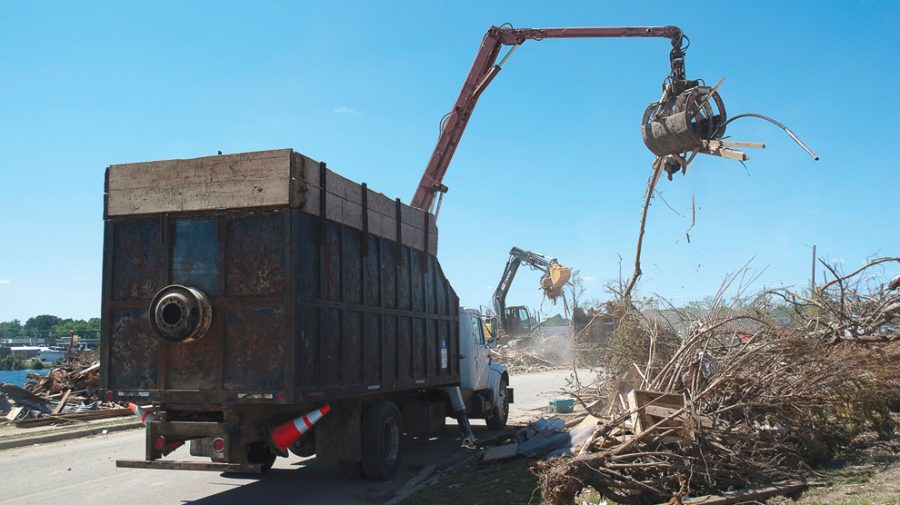By Aug. 1, the city of Tuscaloosa will announce a plan to rebuild what was destroyed by a tornado on April 27. Now, more than a month later, the city is focused on sorting through the rubble.
“We had six and a half square miles of our city completely removed from the map,” Tuscaloosa Mayor Walt Maddox said. “When you couple that with thousands of structures damaged or destroyed, infrastructure needs are critical.”
Maddox said debris removal is what the city will focus on in the coming months, but that officials are also putting together a plan for rebuilding.
“What the tornado did in six minutes, may take us six years to actually recover from,” he said. We have to be patient and we have to understand that this is a marathon.”
The support of countless volunteers, as well as the continued presence of the Federal Emergency Management Agency, will help Tuscaloosa citizens get back on their feet, Maddox said.
“What we have to do is take full advantage of these resources while they’re here now, and I think we’re maximizing the effectiveness of what we’ve received, whether it’s donations or volunteers,” he said.
Although FEMA’s resources are spread to areas suffering from other natural disasters including tornado damage in Joplin, Mo. and Mississippi River flooding, FEMA spokesman Tim Tyson said the number of FEMA workers in Tuscaloosa would not decline.
“It’s always a constant number for us,” Tyson said. “Very few people have been pulled out of Alabama, only a couple that I know of, and that was for personal reasons. If and when someone is reassigned, someone is immediately brought in to replace them. But, for the most part, the people that you’ve been seeing around town are here until the job is done. They’ll be no reduction of commitment.”
Tyson said there are still four disaster recovery centers open – one at Holt Elementary School, one at the American Legion Post, one at Shelby Park and one at the McDonald’s Center.
Tyson said community relations specialists are still canvassing the area to see if they can help those affected by the tornado register for assistance or get in contact with other federal agencies for assistance.
In addition to the community relations specialists, Tyson said FEMA has started with mitigation assistance.
“In some of Tuscaloosa’s larger retail stores, there are tables set up so the mitigation people can talk to survivors and anyone who wants insight on how to build back safer and stronger, or if they need consultation on ways to protect their homes from future storms, primarily by building safe rooms and shelters,” Tyson said.
Tyson said modular housing is now being brought into the county to provide temporary housing for those who lost their homes.
“The best way to fully engage in a full recovery is to be close to where you live, close to where your life revolved before the storm,” Tyson said. “Modular housing enables us to do that.”
As of last week, 76,200 people had registered with FEMA statewide, 11,665 of whom are from Tuscaloosa. The amount of FEMA grants given statewide was more than $43 million. Of that, over $30 million is for housing assistance and over $12 million was for other needs, such as funeral expenses. So far, over $10 million in FEMA grants has been given to those in Tuscaloosa, Tyson said.
Tyson estimated that a total of 3.5 million cubic yards of debris was created by the tornado, 1.5 million of which was in Tuscaloosa County. As of last week, Tyson estimated 1 million cubic yards of debris had been removed from Tuscaloosa.
David Bevens, public information specialist with Alabama Emergency Management Agency, said EMA and its partners are involved on several fronts regarding assistance to those in Tuscaloosa, including assisting with debris cleanup, individual and household assistance and mitigation.
“So far, debris removal in public rights-of-way for both the City of Tuscaloosa and the County of Tuscaloosa are just over 40 percent complete,” Bevens said. “Also, a private debris removal agreement between Tuscaloosa and FEMA has been approved. “
Bevens said EMA will continue to be committed to helping Alabama rebuild.
“Our goal is to help Alabama and its people on the road to recovery from this disaster,” Bevens said. “It is the collective goal of our local and federal partners. In addition, our priorities are the same as those of all survivors: to have a livable home, clearing out debris and rebuilding wisely.”
In regards to moving forward, Bevens said EMA will continue to facilitate and participate in the recovery and rebuilding efforts with their local and federal partners.
“Our focus will be on building a stronger Tuscaloosa, ensuring we don’t forget those who lost their lives in this storm,” Bevens said. “Together we will rebuild Alabama.”









